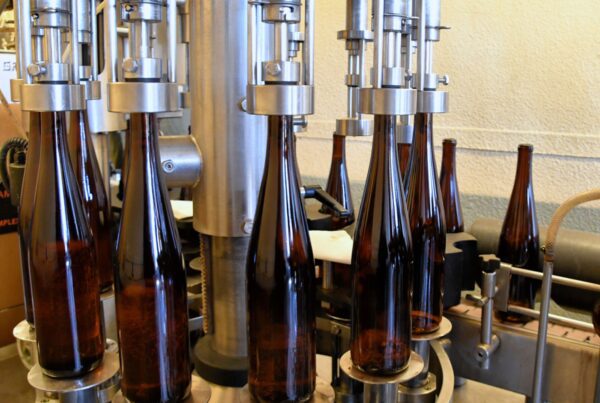You may have heard of tannins but are not sure exactly what they are.
In this article, you will learn what tannins are and what role they play in wine.

Contents
What are tannins?
Simply put, tannins refer to various chemical compounds, called polyphenols, in wine that can affect the color, aging ability and texture of the wine.
The term ‘tannin’ traditionally referred to the use of oak and other bark to tan animal hides into leather.
Tannins in wine come from the grape skins, seeds and stems.
The process of oak aging can also introduce phenolic compounds into wine, most notably vanillin which adds vanilla aroma to wines. Oak chips and tannin powder may also be introduced during the winemaking process to add tannins.
Tannin compounds are found in many species of plants where they play a role in protecting the plant by acting as pesticides. It is also believed that tannins may contribute to regulating plant growth.

What do tannins taste like?
Tannins cannot be smelled, but they can be perceived by the sense of bitterness and the tactile drying sensation that they can create in the mouth after consuming unripe fruit, red wine or tea. This is due to the tendency of tannins to react with proteins, such as those found in saliva.
Purpose of tannins in wine
Tannins have a variety of effects on wine, including color, drinkability and ageing potential.
Tannins, specifically pigmented tannins, influence the color of red wine. Commercial preparations of tannin can also be added at various stages of wine production to improve color durability.
Wine ageing transforms tannins modifying the wine color and lowering astringency.
Levels of tannins in wine
Sunlight increases the concentration of phenolics in grapes. The proportion of the different phenols in any one wine will therefore vary according to the type of vinification.
All wine contains tannins to some degree. Red wine contains more tannins than white wine due to the difference in winemaking techniques.
During the winemaking process for red wines, the grapes are crushed to release the juice, and then the juice, skins, stems and seeds are fermented together. Color, tannins and flavors are extracted from the skins etc.
The amount of time that the grape juice spends in contact with the grape skins, stems and seeds will influence the amount of tannins in the wine. Wines that are subjected to a longer maceration period will have more tannin extract.
White wines and tannins
White wines have less tannins because the grapes are crushed and pressed to separate the juice from the skins etc. before fermentation. Because the juice is not (usually) fermented with the skins or stems, it has less tannins. Tannins in white wine essentially originate from the pulp.
Note: White grapes that are fermented with the skins, produces ‘orange’ wine.
Soft and firm tannins in wine
When tannins are described as ‘soft’ or ‘firm’ it refers to the astringency levels in the wine. Wines that taste bitter or astringent (often young wines) will be described as having ‘firm’ tannins.
Tannins that have been transformed to taste smoother and have a lower astringency through ageing, (barrel and or bottle ageing) may be referred to as having ‘soft’ tannins.
Wines that are high in tannins
The amount of tannins found naturally in grapes varies depending on the variety; however, some of the most tannic grape varieties are:
- Cabernet Sauvignon
- Nebbiolo
- Syrah
- Tannat
Wines that are low in tannins
The best way to avoid tannins in wine is to drink more white and rosé wine, as they contain low levels of tannins, as previously discussed.
Some red wines that have low/medium tannin levels include:
- Pinot Noir
- Gamay
- Barbera
- Malbec

Are tannins good for you?
There have been many studies and headlines suggesting that moderate alcohol (especially red wine) has beneficial effects, with compounds like resveratrol being touted as having health benefits; however, more recently, these studies have been debunked as either unreliable (such as when the study was flawed or paid for by the alcohol industry).
To consume resveratrol in beneficial amounts, for example, is essentially impossible to achieve, and, in the end, eating fresh grapes is much more beneficial.
Drinking any alcohol comes with its risks the same as smoking, eating junk food and not getting enough exercise. So, enjoy a glass of wine, but in moderation, and please don’t enjoy it thinking that it will somehow improve your health.
Tannins and headaches
Some people are genetically sensitive to alcohol and cannot process it as well as others. As a result, they can experience headaches, nausea, vomiting and other kinds of allergic reactions from any alcohol.
Drinking too much alcohol and not enough water will also result in hangover symptoms and is the more likely reason for headaches and nausea than tannins specifically. So, drink in moderation and stay hydrated with lots of water.
If you are convinced that it is tannins giving you headaches or bad hangovers, try swapping red wine for white wine to see if it makes a difference.
Some people also believe that sulfites give them unpleasant side effects. Allergies to sulfites are believed to be very low, but again you can experiment with wines that are low in sulfites.





